When setting up our EVO 13.5, I kept a mindful eye on a budget, but still wanted to go ahead and get all components in place to raise future coral additions. In order to provide flexibility in flow (both in rate and variable patterns), I wanted to get a wavemaker of some sort.
The gold standard in programmable wave makers is the EcoTech Vortex MP10. It has some great features and offers all the capabilities I could ever want, but at a price of $300 USD, this unit would have blown the project budget. In shopping around, I discovered the Aqamai KPS Wavemaker, and it has been an almost perfect addition to our nano.
I’ve had it in use for about a year; It’s been a huge asset to our tank with only a few small negatives. In this review, I will discuss it’s features, setup, and pros/cons of this programmable wavemaker.
EDIT: Please see the important long-term update at the end of this page.
Overview of Saltwater Power heads / Wavemakers:
Flow is an important part of any aquarium, but it can be especially important in a Saltwater tank when trying to make a habitat for various kinds of corals. Certain corals and other saltwater critters may need additional flow other than what is provided from the return pump(s). Additional powerhead(s) can be added to circulate water and produce additional flow.
“Powerheads” as I’m describing here take on the form factor of a motor and impeller housed in a cage, all submersed. These typically attach to the aquarium glass or walls with a suction cup. In function, you can think of it as an underwater desk fan.
“Powerhead” and “wavemaker” are interchangeable terms for similar devices. I consider a powerhead as a constant speed recirculating pump that is placed in the display section of your tank. A wavemaker is different from a powerhead in that it has capabilities to vary the speed of the pump to produce different flow patterns that you don’t get from a constant speed device.
The adjustable flow capabilities of a ‘Wavemaker’ are very desirable – it allows you to tailor the flow patterns and intensity to your tank and inhabitants. Ideally, control of these flow capabilities will be by a graphical interface. Today, that typically means with a smart phone app or internet interface.
Aqamai KPS Specifications and Dimensions:
The Hydor Aquamai KPS Wavemaker is specifically targeted for smaller (10-50 gallon [38-189 liter]) reef aquariums. The wavemaker itself has a DC (direct current) motor, which allows variable speed operation. However, the unit itself is AC (alternating current) with a standard wall plug.
Between the wall plug and the wavemaker is an AC/DC power brick and the ‘hub’ (I’ll call it the control puck) that contains the wireless controller.
Aqamai KPS Specifications and Features:
- Flow: 370-1,050 GPM [1,400-3,975 LPM].
- Recommended for aquariums sized 10-50 gallon [38-189 liter]
- Setup and control through your smartphone through the Aqamai App. Interface is through WiFi (not bluetooth) and when setup, allows control remote (away from your home network).
- Patented DMSS (Dual Magnet Support System) – I’ll describe more later. This mount works on glass up t0 0.59″ [15 mm].
- Listed power consumption of 4-10 watts.
- Six flow patterns to choose from: Constant, Wave, Smooth, Random, Feed, Night.
- Unique flow patterns and intensities can be programmed for each 30 minute interval of a 24 hour day. These flow ‘sets’ can be saved, modified, and swapped.
- Accessories included: (2) adhesive cable clips, (1) cable protector, (1) screw (to mount the control puck)
Aqamai KPS Dimensions:
Here are the dimensions of the Aqamai KPS wavemaker and accessories. As always, I measure to the nearest mm as best I can and convert to inches. There might be some variation between the unit I purchased and others.
- Wavemaker Head: 1.9″ (48 mm) Diameter; 2.1″ (53 mm) wide at cord entrance; 2.6″ (67 mm) Long (from wall to end – including mount)
- Outside Magnet: 1.8″ (46 mm) Diameter; 0.51″ (13 mm) depth (from wall)
- Cord from Head to Controller Puck: 75″ (190 cm) Long
- Controller Puck: 3.9″ (100 mm) Diameter; 0.79″ (20 mm) Deep
- (2) Cords/Connectors from Controller Puck: 5.5″ (14 cm) Long
- Cord from Controller Puck to Power Converter: 37″ (94 cm) Long
- Power Converter: 3.9″ (98 mm) x 1.8″ (45 mm) x 1.2″ (30 mm)
- Cord from Power Converter to Wall Plug: 17.7″ (45 cm) Long
Physical Setup and of the Hydor Aqamai KPS Wavemaker:
On first glance, the KPS wavemaker looks like any standard power head, but it has an ingenious mount that is secure and gives a high range of mounting positions.
I alluded to this in the specifications; KPS acronymned their patented mount DMSS, which stands for Dual Magnet Support System. It’s made up of three parts. On either side of the glass (or other mounting wall) are suction cup mounts supplemented with magnets. I never trust suction cups alone, but with the addition of magnets, this wavemaker has never fallen free or otherwise moved.
The mounting piece on the inside of the tank has a socket like impression that receives the ball shaped end of the wavemaker. The wavemaker ball also contains a magnet, so all three parts (wavemaker, inside mount, outside mount) use magnetic force to hold firm to the glass and to hold the wavemaker position/angle.
The ball/socket shape of the mount and wavemaker lets you have a wide variety of angles to direct flow. You can position the wavemaker in a range of angles from perpendicular to the mounting glass to almost parallel to the glass.
In our EVO 13.5, a natural place to mount the KPS is on back acrylic wall that divides display tank from heater section. Both sides of the mount are fully waterproof so there are no issues with the ‘outside’ magnet being placed inside the wet sump area.
Alternatively, I have played with location and have placed the KPS mounted on the side glass (moving water perpendicular to the glass) on both ends of the tank.
It’s super easy to achieve fine adjustments of position to alter the flow, and the mounting system always holds firm. The one thing to consider is how the power cord will get past the lid to exit the tank. I made the Innovative Marine DIY Mesh Top slightly short to allow room for the cord exit.
For our EVO, the cord travels over the center heater section and down the side of the tank (with all the other cords and tubing).
Beyond setup of the head itself, it’s just an exercise in wrangling wires and components to mount the controller puck in the stand.
Programming and Interface of the Aqamai KPS:
Setup and control of the KPS wavemaker is fairly straight forward. I’ll go through the highlights of setup, programming, and daily use.
WiFi and App Setup:
I’m not gonna lie – getting the KPS and App connected to each other and then to your WiFi network is frustrating and takes a few tries. The good news is once it is setup and connected you will generally not have any problems with. After more than a year in use, it’s still connected and able to control/push out program changes with no issues. Instructions here are specific to my iPhone – Android users may have a slightly different process.
Setup starts with downloading the Aqamai App – the QR code located on the box and in the instructions makes it easy to find.
Once the App is downloaded, start it up. It begins with some request for various permissions (location enable, notifications). Provide the requested permissions.
You are then asked to log in to a service. This will create an account which will save your future data and flow sets.
I initially used my Google account, but it was displaying warnings about access to contacts. I didn’t have a good feeling, backed out, and used my Apple account instead. No surprises using that account option.
The KPS first enables communication through a local WiFi network that it creates. Start by going into Settings and connect to this network. Helpful hint for iPhone users – the iPhone tends to automatically disconnect a network if it does not transmit data. I’d suggest first turning off Cellular data and also going into your normal wireless network and selecting ‘Forget’ so it doesn’t try to switch out of the KPS created network.
When you select the Aqamai_KPS network, it should ask for a password. The default password you need to enter is 12345678.
Once connected, go back to the app and from the ‘Manage’ screen, the new device should show up.
Select the gear icon and you can change various settings, like the device name.
Very important at this point is the “Network Connection” option. This will start the setup process to tie your KPS to your wireless network. Select that option and it will prompt you to select your home wireless network.
I believe at this time (or sometime near this process) you will be prompted to connect to your home network by going back to your phone’s settings.
You will need to enter your home wireless network password:
With some chugging and a little luck, it will connect and you will be set.
Selecting, Creating, and Modifying Flow Sets:
The benefit of this wavemaker is it’s ability to create flow sets and swap between them. A flow set is a 24 hour (daily) cycle of flow and intensity settings.
Aqamai includes several flow sets based on the aquarium type and size. From the “Manage Single Device” page, the current set is listed on line two.
Tap on the flow set and all sets are displayed. Sets provided by Aqamai are not editable. If you want to create your own, tap the “+” in the upper right.
After providing a name, you can select to base it off an existing set or start from scratch.
Each 30 minute time slot needs to be filled with one of the (6) programmed flow movements (which I will discuss a bit later). For each flow movement, you can tap the gear icon to change the settings.
If creating from scratch, you can copy settings from one time slot to the next blank time slot by sliding down across the arrow at the bottom (although this gesture is finicky and only works every 3rd or 5th time I try it).
Once you build and save your set, it will show up in your set list. When you select the flow set by tapping on it, it will show up on your ‘Manage Single Device’ page. Complete pushing this set to your device by toggling the slider to the right (from red to green).
Explanation of Flow Movements:
I’ll give a brief description of each of flow movement including their parameters. Portions in quotes are from Aqamai’s Website
Constant Flow: The simplest of patterns, this makes the wavemaker operate at constant speed. Adjustable parameters: Flow Intensity (from 0% to 100%)
Wave: This pattern is intended to make the wavemaker . . . make some waves. Adjustable parameters: Minimum and maximum flows (from 0% to 100%), Wave frequency (250 ms to 2.5 seconds). It’s best to play around with intensities and the frequency, observe the effects, and adjust to get the desired wave. Each tank will have a different ‘natural frequency’ where certain settings will better setup an efficient standing wave.
Smooth: “The pump varies its power between the percentage values min/max selected. Starting from the minimun value it get to maximum value and reaches fluidly back to the minimum value, thus restarting the cycle. Time is random.” This setting is very similar to Wave, except the frequency randomly fluctuates. Adjustable parameters: Minimum and maximum flows (from 0% to 100%)
Random: “The pump varies its power between the percentage values min/max selected according to random flow and random time.” Adjustable parameters: Minimum and maximum flows (from 0% to 100%)
Feed: “This program works as the constant flow and allows, in the daily programming, to be set for a time under 30 minutes. Ideal to lower or turn off the flow during the feeding time.” This setting is beneficial for setup with an automatic feeder – it allows for lower settings to be dialed in during feeding and can be set for less than the full 30 minute time slot. The feed setting can be used multiple times a day but can’t be used in consecutive time slots. Adjustable parameters: Flow Intensity (from 0% to 100%) and Feed Duration (from 5 minutes to 30 minutes in 5 minute increments).
Night: “This program works as constant flow and introduces energy saving for a reduce waste during the night.” I honestly have no idea how this differs from Constant Flow. I’m guessing it operates at a lower range of flows compared to other movements. Adjustable parameters: Flow Intensity (from 0% to 100%).
Have fun playing with all the settings. I will say that 100% intensity for any of these patterns is overkill for a small tank like our EVO. I rarely use settings over 50%.
To easily sample from one setting to the next, go to the “Manage Single Device” page, line one – click the “Demo” button.
Final Operating Tips for the Aqamai KPS:
A few last items of operation for this wavemaker. The controller puck has a small button on the bottom (hidden near where the two wires exit). If you hold this button down for 10 seconds, it will perform a factory reset on the unit.
If you press and hold this button for two seconds, the pump will shut off for a period of 10 minutes. This is helpful as a makeshift manual feed mode.
The controller puck has a small LED that illuminates downwards. The various LED modes represent:
- Solid Yellow: the unit is operating in Constant Flow mode.
- Blinking Orange: the unit is operating in Wave mode.
- Solid Purple: the unit is operating in Smooth mode.
- Solid Green: the unit is operating in Random mode.
- Solid Cyan: the unit is operating in Feed mode.
- Solid Blue: the unit is operating in Night mode.
- Blinking White: the unit is in Demo (pump off) mode. To enter this mode, press the controller button for 2 seconds to stop the pump; press the controller button again to restart the pump (or wait 10 minutes and the pump will resume the normal schedule).
- Blinking Red: the pump rotor is locked or blocked by something. The pump will disable for one minute and then energize to check if the pump is free (in which case the normal schedule will resume) or turn off for another minute (if the pump is still blocked).
- Blinking Blue: The unit is experiencing network connection issues.
- Blinking Red/Green: Hardware error. Contact the manufacturer.
Desired Improvements for the Aqamai KPS Wavemaker:
The KPS Wavemaker is a splendid product. I’ll get to the positives and overall recommendation in a bit. Let’s get the negatives out of the way – Here are a few things that bug me or that could be improved:
- The app interface is not very polished. This is somewhat to be expected – it’s a small company. However, they need to improve the prompts and instructions for the initial setup. There needs to be guidance all the way through connection to your home network.
- The interface for building a set takes too long. With 48 time slots to fill, it should be easier to quickly copy settings across a large span of time.
- The mode button on the control puck is too small and hard to get to.
- The only way to pause (to simulate a feed [pump off] scenario) is to use the aforementioned mode button. It would be better to have a dedicated ‘feed’ button on the front of the control puck that can be programmed for a desired flow rate and duration when pressed.
- The LED isn’t all that helpful for communicating unit status as there are too many color combinations to remember. A single line LCD would be better and wouldn’t break the bank.
- Smart device integration would be much more useful if Homekit or Alexa was enabled, allowing voice control and commands of the device. Being able to use Siri and simply say “Start Feed Mode” or “Turn off Wavemaker” would be tremendously useful. As it is, getting my phone out and navigating to and through the app seems really inefficient.
Conclusions on the Aqamai KPS Wavemaker:
I love the Aqamai KPS. I’m very thankful that this product exists. As I said in the intro, without the KPS, I’d be stuck spending more than double the price of Aqamai’s unit ($120 USD) for the EcoTech Vortex MP10. Honestly, I think the KPS is better than the MP10 in some ways (better size for a nano, not sure wire/motor outside the tank is the best).
You will notice all of the negatives deal with the interface – the physical setup and performance is stellar. The size is perfect for a nano reef tank with plenty of power to spare. The magnet/suction cup mount has never let me down and is surprisingly versatile.
Despite some frustration with the app interface, I have been able to dial in a flow set for every phase of the marine hobby thus far. I lowered flow rates when I got a few LPS corals. If I get into SPS corals and want to try higher flow rates, that adjustment will be no problem for the KPS.
Bottom line is that the Aqamai KPS Wavemaker is by far the value leader for small reef aquariums. Even without the fiscal advantage, it’s programmable capabilities and it’s small size put it ahead of all competitors for smaller nano tanks.
Newcomer Competition:
There is one new option as an alternative to the KPS and that is the AquaIllumination AI Nero 3. It is priced very close at $165 USD. I’d imagine the interface is better (although can’t say for sure until I try it). The Nero line is bluetooth controlled instead of WiFi so it can’t be controlled outside your house (which is honestly rarely needed).
Downside of the Nero 3 is it is larger (dimensionally) than the KPS so not perfectly suited for a small nano like the EVO 13.5. If I needed a programmable wavemaker for a slightly larger nano, I’d put the Nero 3 at the top of the list. My curiosity is piqued about this unit and I might have to pick one up for a review and comparison.
Long Term Update on the Aqamai KPS Wavemaker:
Well, It pains me to make this update, but we’ve had problems with our Aqamai KPS pump. About [timeframe] after installation, the unit started to cycle off with a red flashing error light on the controller. This means a ‘locked rotor’ of sorts. Cycling the unit off and then on usually cleared the issue for a short while, but the issue always returned.
The issue progressed to the point where the pump did not run for more than half an hour before shutting down with the error. At this point, it was clear the pump was defective and needed to be replaced. I was not hopeful for a warranty replacement (free of charge) but was at least expecting an opportunity to purchase just the replacement pump (without controller puck and power supply) at a reduced cost (compared to the entire unit).
I started with the warranty card included with the device. No luck. Left a message and never got any reply. I also tried the internet but could not find any contact forms for Aqamai (owned by parent company Hydor). The email address circulating the web for Hydor did not yield a reply.
Based on this, I have to report that there is no support at all for this wavemaker, at least not from the manufacturer. Any support you get will be from the retailer that you purchase the unit from.
I don’t necessarily fault the Aqamai KPS Wavemaker for having a failed component – it happens. Nothing in manufacturing is perfect and the marine environment that we subject equipment to is very harsh. However, I can’t recommend this product because of the complete lack of support.
I have since moved on to the AquaIllumination AI Nero 3. Even it had an issue with a pump that needed to be replaced, but they proved to be extremely responsive in providing a free replacement. I will be posting a detailed review of that unit shortly.


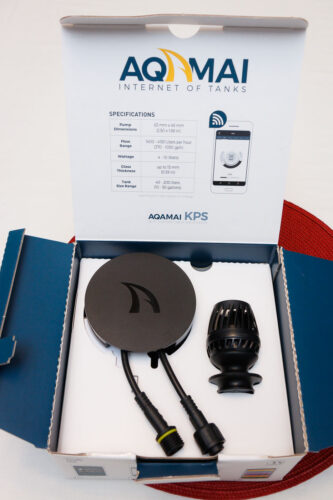
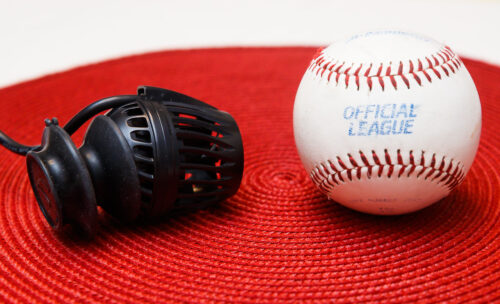
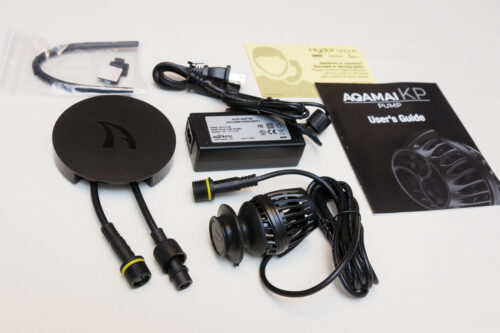
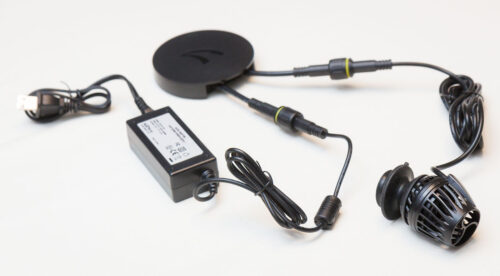
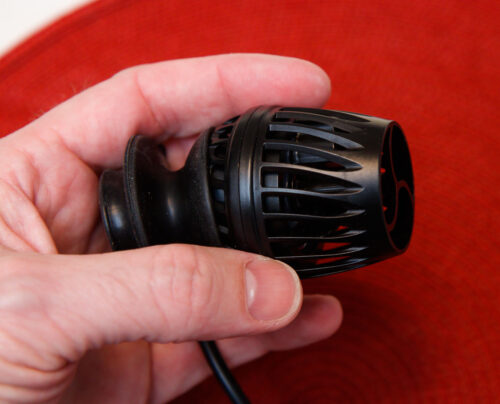
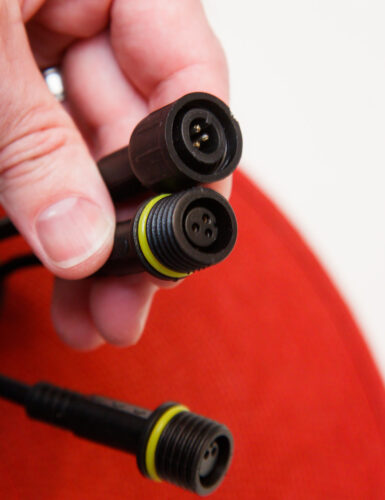
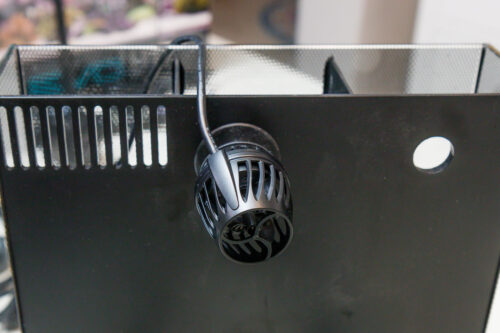
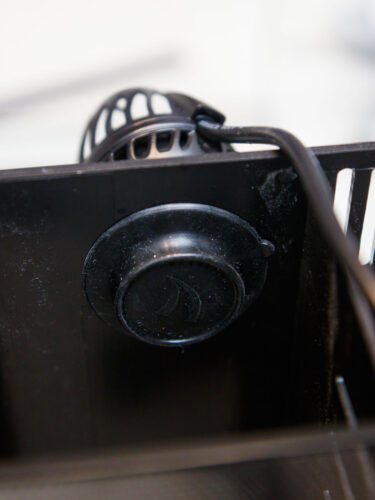
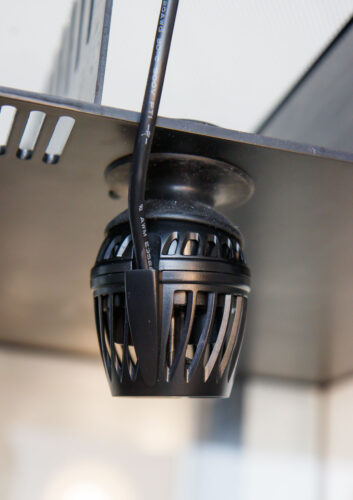
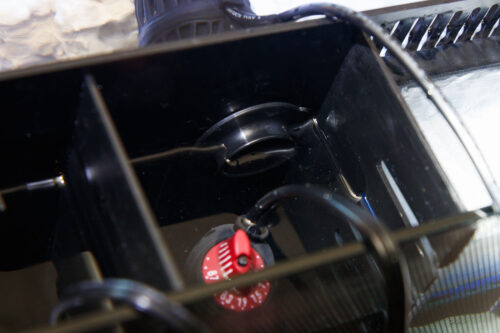
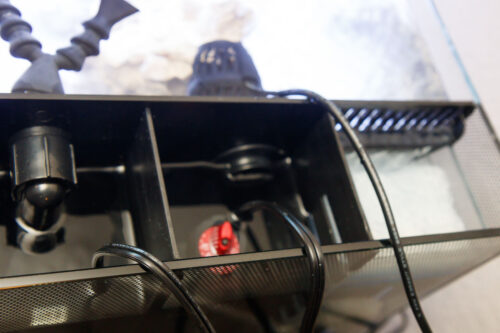
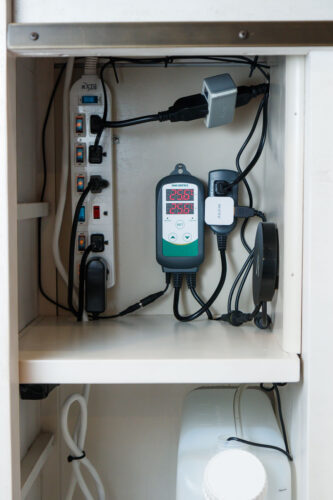
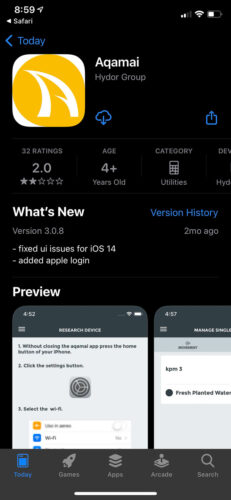

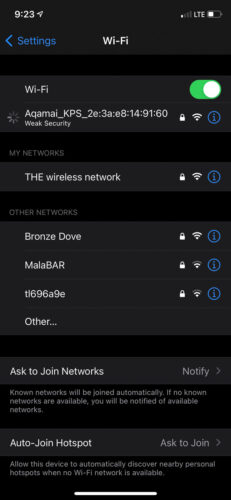
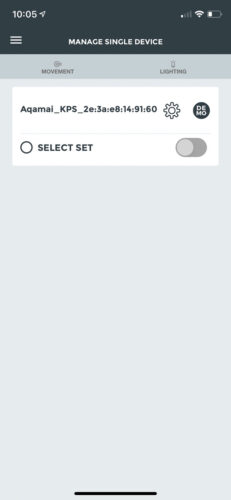
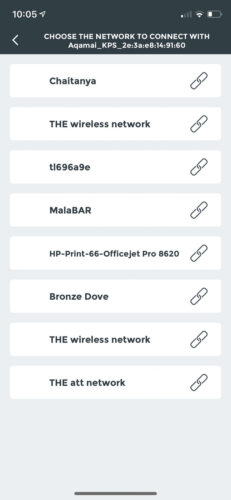
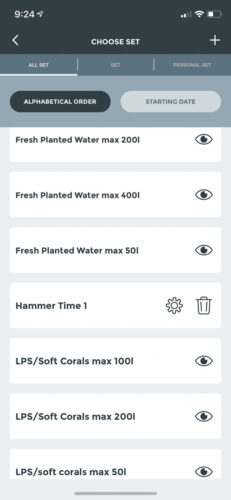
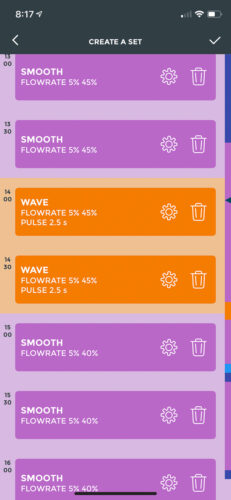
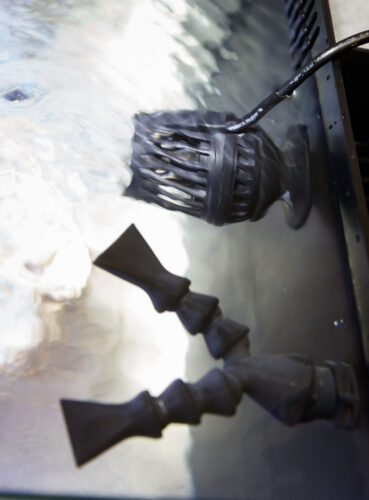
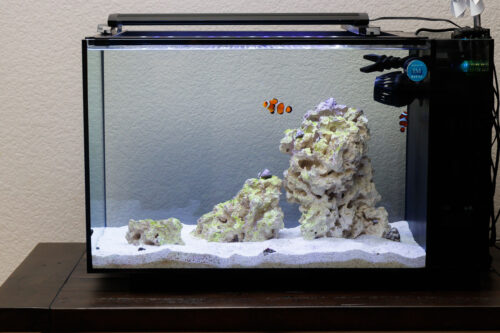

Thank you for creating this blog!; I had a similar experience with the EVO 5 and everything I read here looks to be exactly what Im looking for on my Fluval 13.5
I was set on purchasing the Tunze Turbelle Nano, but this unit is less than half of the price. The Tunze worked great on the EVO 5, but it was overkill as I could only use it with the dial turned to 5.
Would like to give it a try, will have to install it right bellow the main pump nozzle as the other two compartments have the inTank baskets
That location will work. I’ve had good luck on the ‘side’ glass (near the corner of filter section wall) as well.